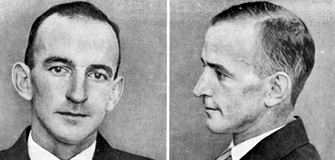On 16 October 1933 the body of Mrs Christobel Lakey
was found dead in a duck pond. Her husband Samuel could not be found.
Also missing were two guns which were found on the land of a
neighbouring farm owned by a man called William Alfred Bayly.
When the police spoke to Bayly he was very quick to
point the finger of blame and he suggested to the police that Mr Lakey
had murdered his wife but when the police started investigating they
found that due to arguments over fences and access roads there had been
quite a lot of bad blood between Bayly and the Lakeys.
On searching Baylys farm they found a lot of evidence
that a body had been burnt in an oil drum and then the remains scattered
over the orchard and fields. Human hair and fragments of bone plus blood
and denture material helped to accuse him. The police then found a Watch
and lighter belonging to the dead man. Bayly was found guilty and hanged
in Auckland prison at 8 am on 20 July 1934.
On 5 October 1928 the body of Bayly's 17-year-old
cousin Elsie Walker was found in bushes near a quarry at Panmure. She
had a small bruise on her head, but it was initially unclear whether
this was the cause of death. Elsie had been living with the Baylys at
Papamoa for the past year and had gone missing on the night of 1 October.
There were local rumours that Bill Bayly was involved in her death.
Public disquiet grew as an implausible scenario was
constructed by the police: Elsie, a young woman who probably could not
drive, was said to have stolen a car and negotiated 150 miles of
back-country roads at night before abandoning the vehicle and walking
eight miles to the quarry, whereupon she died, either from exposure or
exhaustion. In December doctors decided that Elsie Walker had probably
died of 'concussion following a blow on the head'. There was semen on
her underclothing, but 'no sign of rape'.
The coroner's inquest, held in January 1929, found
that there was no evidence to say whether the death had been accidental
or homicidal. Bill Bayly and other members of his family all testified
that he was in Auckland when Elsie Walker disappeared. The coroner, F.
K. Hunt, criticised police bungling in the early stages of the
investigation. Believing this meant 'suspicion may rest against a
perfectly innocent man for the rest of his life', he called for a public
inquiry.
The commission of inquiry, conducted by Edward Page,
a stipendiary magistrate, reported in March 1929 that police enquiries
had been 'prompt, thorough and exhaustive', and that existing procedures
were satisfactory. However, in August New Zealand Truth revealed
that two women were claiming to have seen Bill Bayly at Papamoa on the
day of Walker's disappearance; there were suggestions one of the women
had been attempting to blackmail his mother. Demands from women's groups
for a reopening of the inquest were supported by the coroner. But on the
same day that a petition of over 15,000 signatures was recommended for
favourable consideration by the parliamentary public petitions committee,
Minister of Justice Thomas Wilford declared that because the women's
conflicting statements would not stand up in court, he would not amend
the Coroners Act 1908 to enable a second inquest. Although the act was
amended the following year, the case was never reopened.
Meanwhile, Bill and Phyllis Bayly had been dairy
farming at Ruawaro, near Huntly, since November 1928. Their immediate
neighbours were Samuel and Christobel Lakey, who had bought their
property from Frank Bayly. Samuel had earlier worked as a carpenter for
Frank at Ruawaro and at Karaka and Papamoa. Relations between Bill Bayly
and the Lakeys were initially friendly, but deteriorated to the point
where Christobel Lakey is said to have accused Bayly of having murdered
Elsie Walker, saying also that she and her husband expected the same
fate.
On 16 October 1933 Christobel's body was discovered
lying face down in a pond near the Lakeys' farmhouse. Some speculated
that her husband had killed her and perhaps himself, but it soon became
evident that both Lakeys had been the victims of foul play. On 18
October bloodstains were found on a wheeled frame near the boundary
between the Lakey and Bayly farms, and the following day the police
began searching the Baylys' property. Bloodstains were discovered on
Bill's sledge, guns missing from the Lakeys' house were found buried in
his swamp, and chemical tests revealed charred bone fragments on a
shovel taken from his cowshed.
In December Bayly, who had been under surveillance by
the police, disappeared, leaving a suicide note. He soon surfaced in
Auckland, and was arrested for the murder of Christobel Lakey. As the
search continued, human bones and items of clothing were found in
Bayly's garden. It appeared that Lakey, his best suit and a pair of
boots belonging to a friend had been incinerated. On 10 January 1934
Bayly was charged with Samuel Lakey's murder.
The trial, before Justice A. L. Herdman, opened in
Auckland on 21 May 1934. The prosecution, led by Vincent Meredith, took
more than three weeks to present its case. 'Pathology, physics,
ballistics, and photography contributed evidence…the probative force of
which was convincing almost to a startling degree.' The defence called
no evidence. Senior counsel Erima Northcroft spent nearly four days
attacking the Crown's case, but on the 29th day of the trial the jury
took barely an hour to find Bayly guilty on both counts. Petitions
seeking commutation of the death sentence or a new trial were
unsuccessful. Protesting his innocence to the last, Bayly was hanged in
Mount Eden prison, Auckland, on 20 July 1934. He was survived by his
wife and two young sons. The Bayly case aroused unprecedented interest
at the time and has continued to fascinate the New Zealand public.

